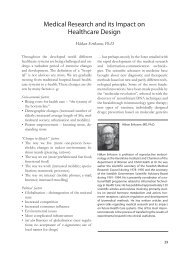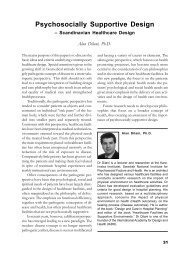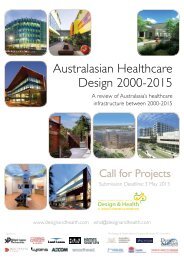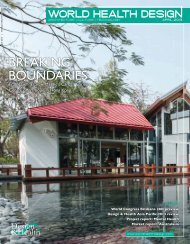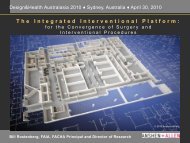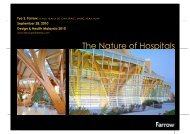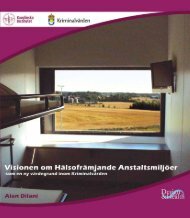SUPER GREEN - the International Academy of Design and Health
SUPER GREEN - the International Academy of Design and Health
SUPER GREEN - the International Academy of Design and Health
- No tags were found...
You also want an ePaper? Increase the reach of your titles
YUMPU automatically turns print PDFs into web optimized ePapers that Google loves.
<strong>Design</strong> & <strong>Health</strong> Scientific ReviewUrban <strong>Design</strong><strong>Design</strong>ing <strong>Health</strong>y Communities:The health impact <strong>of</strong> streetvendor environmentsThis study, spanning seven years, reveals how <strong>the</strong> informal architecture <strong>of</strong> <strong>the</strong> environments, in whichstreet vendors ply <strong>the</strong>ir wares in countries like <strong>the</strong> Philippines, impacts on <strong>the</strong>ir healthMary Anne Alabanza Akers, PhD, Timothy AAkers, PhDThe built environment plays a powerfulrole in <strong>the</strong> health <strong>of</strong> a population.Its infl uence has been documentedin numerous studies, ranging from urbansprawl <strong>and</strong> its impact on obesity, diabetes<strong>and</strong> poor nutrition to highway development<strong>and</strong> <strong>the</strong> increase in pedestrian injury, <strong>and</strong> <strong>the</strong>impact <strong>of</strong> nature deprivation on low mentalhealth <strong>and</strong> well-being. However, many <strong>of</strong> <strong>the</strong>existing studies have not used comprehensiveresearch designs <strong>and</strong> methods; <strong>the</strong>y lackmultiple study points in time; <strong>and</strong> <strong>the</strong>y havenot interviewed respondents in situ.This study contributes a perspective <strong>of</strong>design <strong>and</strong> health that goes beyond designinghealthcare facilities for patients who arealready diagnosed with health problems.It unveils a different world <strong>of</strong> people whowork in busy, <strong>of</strong>ten chaotic, <strong>and</strong> noisy urbanstreets. Their environments are temporary,marginal, uncertain <strong>and</strong> fl uid.Such informal architecture is found in urbanplaces all over <strong>the</strong> world 1 . In this context, itinvolves viewing <strong>the</strong> built environment withina framework that includes street people’scultural lifestyles, socio-economic values <strong>and</strong>spatial behaviour.Baguio City street vendorsThis study comprises a longitudinal <strong>and</strong>transdisciplinary study <strong>of</strong> street vendors inBaguio City in <strong>the</strong> Philippines. It is a fastgrowingregional centre for higher education,medical services, business opportunities <strong>and</strong>tourism. Situated in <strong>the</strong> rugged upl<strong>and</strong> region<strong>of</strong> <strong>the</strong> Cordillera Mountains, <strong>the</strong> city wasplanned for 50,000 people but now holdsabout 250,000 residents. Lack <strong>of</strong> <strong>of</strong>fi cial jobs<strong>and</strong> <strong>the</strong> economic downturn <strong>of</strong> many globalcities have driven residents to legitimatelyearn a living on urban streets.Typical female street vendors in Baguio City, out in <strong>the</strong> open, exposed to traffi c pollution, wea<strong>the</strong>r <strong>and</strong> diseaseStreet vendors create spaces withinexisting buildings, sidewalks <strong>and</strong> streetsto establish <strong>the</strong>ir ‘territories’ <strong>and</strong> sell <strong>the</strong>irproducts. The result is a tapestry <strong>of</strong> informalarchitecture set on <strong>the</strong> existing builtenvironmentinfrastructure. The questionis: “How does <strong>the</strong> architecture impact onstreet vendors’ health?”Literature on <strong>the</strong> health <strong>of</strong> street vendorshas focused largely on studies related topublic safety <strong>and</strong> food-borne diseases. O<strong>the</strong>rresearch projects have examined vendorhealth in terms <strong>of</strong> pollutant contamination in<strong>the</strong>ir bodies <strong>and</strong> reproductive conditions 2,3,4 .These studies generally imply that vendors’presence in <strong>the</strong> streets for long periods <strong>of</strong>time poses an occupational health hazard.However, to date, no study has delvedinto <strong>the</strong> physical environment – <strong>the</strong>architecture <strong>and</strong> l<strong>and</strong>-form features – <strong>and</strong>its contribution to <strong>the</strong> health conditions <strong>of</strong>vendors. Fur<strong>the</strong>rmore, design guidelines tomitigate <strong>the</strong>ir health circumstances have notbeen addressed. This paper hopes to lessenthis gap in <strong>the</strong> literature.The study involved multiple researchmethods from 1999 to 2006. Table 1(see p59) describes <strong>the</strong> various researchphases <strong>of</strong> <strong>the</strong> project. The methods rangedfrom personal surveys <strong>and</strong> physical placeassessments to health screening procedures.This eclectic use <strong>of</strong> research techniqueshas contributed to a comprehensiveunderst<strong>and</strong>ing <strong>of</strong> vendors <strong>and</strong> <strong>the</strong> impact <strong>of</strong><strong>the</strong> street environments on <strong>the</strong>ir health.Throughout <strong>the</strong> seven-year duration<strong>of</strong> <strong>the</strong> research project, two surveys wereconducted – one in 1999 <strong>and</strong> <strong>the</strong> o<strong>the</strong>rin 2003 – with samples <strong>of</strong> 219 <strong>and</strong> 187respondents, respectively. Many <strong>of</strong> <strong>the</strong>seindividuals were repeat respondents.Generally, <strong>the</strong> characteristics <strong>of</strong> <strong>the</strong> vendorsare <strong>the</strong> following:• At least 80% are women in <strong>the</strong>irearly 40s• They have an average <strong>of</strong> four children.• At least 50% have a high schooleducation• The majority <strong>of</strong> respondents have stayedin <strong>the</strong> same vending locations between sevenWORLD HEALTH DESIGN | October Summer 2008 00 55



